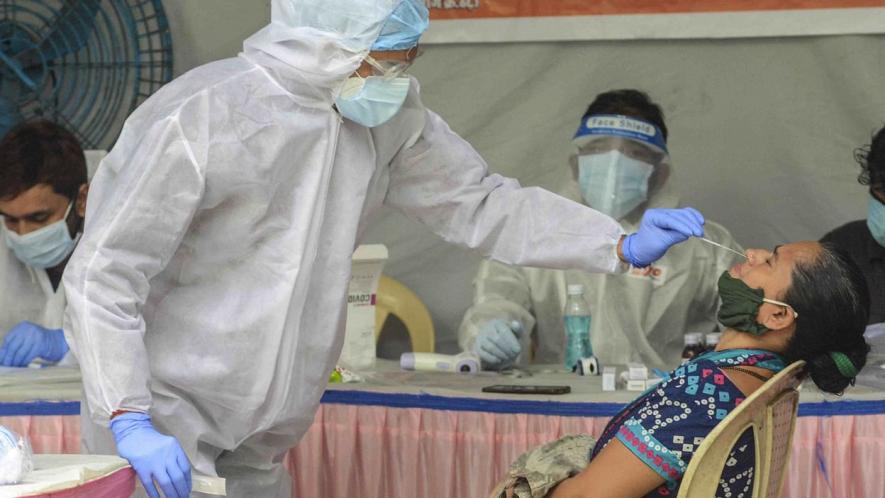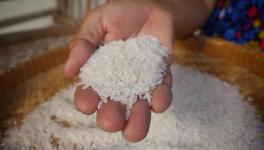AIIMS-IIT Bhubaneswar Study: Can Winter Bring a Spike in COVID-19 Cases?

Representational image. | The Quint
A joint study by the Indian Institute of Technology, Bhubaneswar and All India Institute of Medical Sciences (AIIMS) Bhubaneswar has drawn some serious conclusions one of which is: with a decrease in temperature and an increase in humidity, the COVID-19 cases in India might go up. Imperatively, the ongoing monsoon season and the ensuing winter may manifest into a spike of the disease, if we go by the study’s highlights.
This is something worrisome when the confirmed cases in the country have crossed the million mark and death toll is nearing 30,000. Any future surge in the number of fresh cases may have a more disastrous effect on public health and the economy alike.
Responding to the study findings and the explicit claims made, Prof Satyajit Rath, an adjunct faculty of IISER Pune and an immunologist said, “The pre-print from Vinoj and colleagues is a relatively simple exercise correlating COVID-19 'case' numbers and their doubling time with weather conditions such as ambient temperature and humidity. The general biological argument being used, that spread of most of the [not all] respiratory viral infections tends to be somewhat helped by low temperatures and humidity, is fair enough. However, there are a number of worries about the speculative interpretations offered. To begin with, extending a correlation between two sets of data into an inferred causal relationship between them is very tentative speculation at best and an outright basic fallacy at worst. Yet, this is what the manuscript explicitly claims, as can be seen from the 'Highlights' it offers.”
The yet-to-be peer-reviewed study uploaded on a preprint server has three highlights, which are:
-
The increase (decrease) in temperature leads to a decrease (increase) in COVID-19 spread. A 1ºC rise in temperature leads to the decline in disease cases by 0.99% and increases the doubling time by ~ 1.13 days.
-
Similarly, an increase in relative humidity tends to increase the growth rate and decrease the doubling time ~ 1.18 days.
3. Increasing solar radiation decreases disease cases and increases their doubling time.
4. There is significant potential for spread due to unfavorable environmental conditions towards monsoon,post-monsoon, and winter.
Prof. Rath added, “As can be seen from the highlights (the verbs used), there is an explicit claim about a cause-and-effect relationship being made. This claim of demonstrated causality is completely unsupported by evidence. Speculation of causality would be interesting if there had been any effort at addressing potential confounding factors. The authors note some of these confounding factors; yet, make no effort to account for them in the analysis.”
The confounding factors Dr Rath referred to can be seen in the following paragraph from the paper:
"Although several factors, including population density, testing capacities, public awareness, differing resilience to a health crisis, and early implementation of lockdown measures could have contributed to these differences, it is also speculated that meteorological/environmental factors could also contribute to these differences."
Regarding this, Rath said, “In fact, the basic regional unit Vinoj and colleagues use (in common with many other workers across the world) for comparisons here is a political entity: in this case, the individual states of the union (or at least, those with substantial population densities). But this means that the demographic and socio-political features (which the authors allude to in the quote above) are almost guaranteed to be different, increasing the chances of confounding the analysis. It also means that major within-state variations in the parameters being studied are ignored. As a result, sadly, the causality claims being made tend towards being more likely to be fallacies rather than being potentially interesting speculations. Further, the correlations being reported are quite modest, with only peripheral implications for policy-making, if we keep in mind the fact that the purpose of public policy is to limit the rate of spread of the infection.”
Besides, several other critical issues need a careful investigation. Firstly, the study is overpowered by statistical analysis and little attention has been given to the virus physiology and its spread behaviour. The observed decrease in cases may be ascertained to other physiological factors and genetics of the virus as well. Moreover, the period that the study considers, April 20 to June 5, could also have some impact on the observed results. Till early May, there was a countrywide lockdown, which could have helped in decreasing the number of infections in April-May.
Secondly, In India itself, the rise in COVID-19 cases is apparently not directly correlated to temperature and other weather factors. For example, in Assam, July and August are the months when summer peaks, not in May or June. But Assam is witnessing a massive surge now.
Thirdly, the virus is not restricted to India alone. In some European countries, the terrible peak was in February-March. But after suspending the lockdown, many countries have witnessed a resurgence of cases. despite higher temperatures; for example, in Germany.
Regarding the humidity and the viral spread, we need to consider why some viruses like influenza peak in winter when the humidity is decreased and remain inactive in summer when humidity increases. This is due to the presence of an additional outer coating present in some viruses called ‘the envelope’. The enveloped viruses are fragile in adverse conditions. The coronavirus causing the COVID-19 pandemic is also an enveloped virus and going by the logic of humidity adversely affecting enveloped viruses, the novel coronavirus should also have remained inactive in the summers. But this did not happen.
In this context, NewsClick sent a questionnaire to the authors of the study, but did not get a response.
What is worrisome more than the study itself is the way it has been highlighted by the media. This can enable the governments to put the onus on the weather, undermining human intervention. However, we have witnessed that where systematic and extensive human intervention is present, the spread of the disease is controllable. A policy failure makes the situation worse.
Get the latest reports & analysis with people's perspective on Protests, movements & deep analytical videos, discussions of the current affairs in your Telegram app. Subscribe to NewsClick's Telegram channel & get Real-Time updates on stories, as they get published on our website.
























